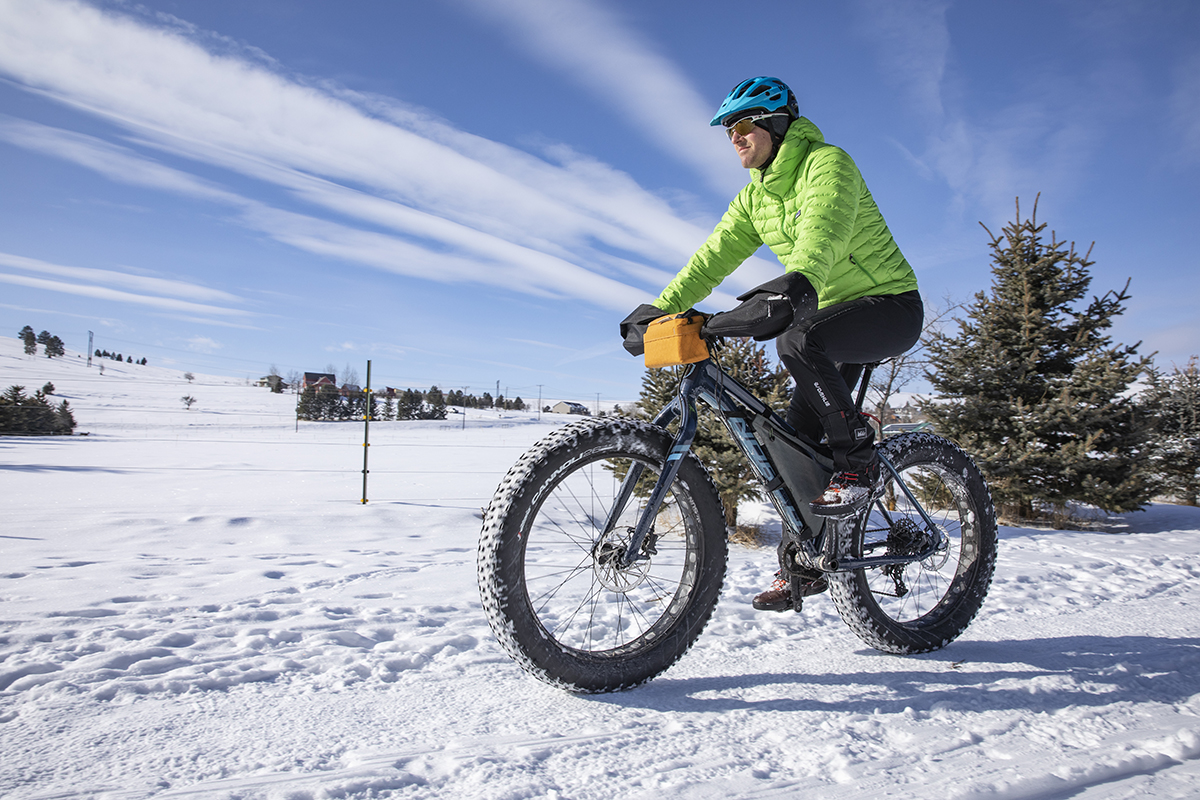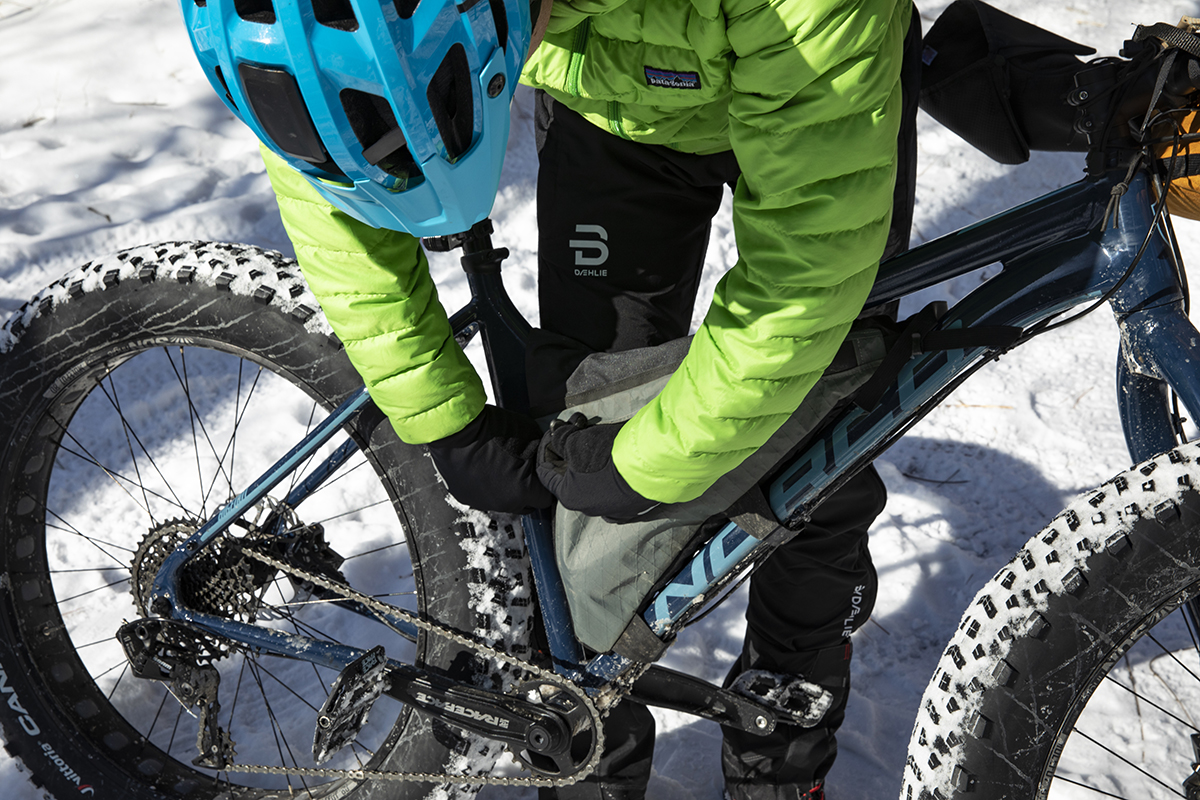Road Test: Norco Bigfoot 1
Years ago, at a hostel in the tiny mining town of Silverton, Colorado, I met a gold panner named Bible John. He was thumbing through a hunting catalog, looking at ghillie suits. He told me he was going to find Bigfoot.
Naturally, I asked him what he would use to kill Bigfoot.
Kill him?! Heavens no — Bible John wanted to bring Bigfoot to Jesus.
Naturally.
But Bible John was wrong. Bigfoot isn’t from Colorado, he’s from British Columbia. And he’s not a mythical, ape-like creature that walks upright. He’s a fat bike. And an affordable one at that.
Getting Fat in Winter
If you live in a climate that sees real winter — with, like, snow — a fat bike just might be the key for year-round riding. Oh sure, you can throw studded tires on your commuter and fight through the snow and slush, but soon enough you’ll come across conditions that’ll stop your skinny-tired bike cold. And then you’ll be walking. How pedestrian.
Winter bikes get treated poorly, so to properly review a do-it-all winter fat bike such as the Norco Bigfoot you see here, I acted accordingly. I kept it outside where it weathered all kinds of, uh, weather, including a couple of beastly windstorms, one of which ripped a headlight off the handlebar and flung it into the abyss. I commuted on Missoula’s indifferently plowed streets, arriving at my destination with much of the Bigfoot’s nethers covered in road sludge. I lubed the chain … occasionally. And I used the Bigfoot as my winter trail bike, hitting packed-down local singletrack and groomed trails alike.

The Spec
Just in case you haven’t been paying attention, the fat bike market has exploded in recent years, offering buyers everything from the venerable chromoly land cruisers to lightweight carbon race machines. The Bigfoot lands somewhere in the middle. It’s got an aluminum alloy frame and fork to keep both cost and weight down, although Norco had arguably more success with the former than the latter — more on weight later.
And it’s got all the features to make it a versatile rig: rack mounts in the rear, bottle mounts on both sides of the down tube, and triple mounts on the fork. The only real cost-saving measure on the frame is the quick-release rear dropout, which caused me zero issues.
The component spec is likewise affordable but solid. The Race Face crank spun smoothly, and SRAM’s NX 11-speed drivetrain shifted well enough, at least when I had it properly adjusted. With a 28T chainring, I had a nice, low gear for climbing, and I never felt like I needed anything more on the top end.
I’ve had mixed results with SRAM’s budget-priced hydraulic disc brakes on other bikes, but these Levels felt good and performed flawlessly throughout the test period. My only gripe is with the clamps. You have to slide them on or off the handlebar, and they take up so much room that I couldn’t get both the brake lever and shifter into my ideal position.
I would have preferred SRAM’s Level T brake and its MatchMaker-compatible clamp, but according to Paul Burnett, Norco’s senior product manager, it would have raised the Bigfoot’s retail price too much.
Norco clearly understands fat biking, because they’ve included a dropper post on the Bigfoot. Don’t think you need one? Try getting back onto your fat bike while standing in deep snow. The TranzX dropper worked great from Day 1, although I’m not a fan of the included lever, which mounted so closely to the bar that the grip interfered with the lever’s action (I eventually switched the factory grips for thick foam grips, and the problem remained). I had to move the lever so far inboard that I had to unwrap my thumb to press it. Norco’s Burnett said they’re aware of the issue and are working on developing their own dropper lever.
The Numbers
Where other fat bikes we’ve reviewed on these web pages have been at the sharp end of the geometry spectrum (Otso Voytek, Salsa Mukluk), the Bigfoot is a little different. It’s got a taller stack height, a slacker head tube angle, and a longer wheelbase, all of which add up to a steady, stable ride. It also has a very slack seat tube angle, which makes it feel like it has a longer reach than the geometry chart would suggest. I’m normally not a fan of slack seat tube angles, but it kind of makes sense on a fat bike — it puts more of your weight over the rear wheel, making it easier to find traction in soft conditions.
Another big difference between the Bigfoot and the Otso (and another fat bike I’ve reviewed, the Rocky Mountain Suzi Q) is that the Bigfoot has a traditional fat bike Q-Factor. In other words, a wide Q-Factor. My knees don’t particularly enjoy this aspect of fat biking, but as long as I don’t hammer on the pedals and I keep my rides relatively short (less than two hours), I get along just fine. If you don’t know how you’ll fare with a wide Q-Factor, it might be worth renting a fat bike or taking one for a longish test drive.
Let’s talk about another number: the standover height. A low standover is mandatory for a fat bike, especially if you plan on riding in snow. If you’ve ever experienced a get-off in deep snow, you know what I’m talking about. Luckily, the large Bigfoot’s 755mm figure is spot-on, leaving a big enough front triangle to fit a smallish framebag (my large Oveja Negra Superwedgie fits nearly perfectly).

The Fat and the Slow
While riding with friends, I had the distinct feeling that something was slowing me down. (It couldn’t have been my lack of fitness. Surely not.) I own a steel-framed fat bike that, while heavier, felt noticeably quicker than the Bigfoot. I wheeled the Bigfoot into my local shop to see whether anything was causing drag in the drivetrain or wheels, but the mechanic found everything to be in order. The problem? Heavy tires.
Vittoria claims a little more than 2,000 grams for its 26 x 4.8in. Cannoli tire. That’s pretty heavy, even for a fat bike tire. Two thousand grams is about 4.4 lbs. That’s nearly 9 lbs. of tire alone on the Bigfoot, and that doesn’t even account for the undoubtedly heavy tubes. For reference, the 4.6in. tires on my personal fat bike weigh in the neighborhood of 1,500 grams each — that’s a pound less per wheel compared to the Bigfoot, and they’re set up tubeless. No wonder my bike feels faster.
Setting the wheels up tubeless would save a good deal of rotating weight, making the Bigfoot feel lighter on its feet. Luckily, both the tires and the Mulefüt rims are tubeless-ready. You’ll just have to ask your local Norco dealer to set them up for you.
Switching to a lighter tire, or a narrow one, would also help, but I would caution against going narrower. If you’re planning on riding mainly dirt and firm, groomed snow, 4.0in. tires are just fine and probably worth the drop in rotating weight. But if your fat biking involves variable snow conditions, go full fat. You’ll be turning heavier rubber, but the extra flotation will give you more grip.
Staying Fat
Whether you’re looking for a nearly unstoppable winter bike, a do-it-all trail rig, or just a fun, fat ride to add to your quiver, the Bigfoot is worth your attention. At 36.5 lbs. it’s not a featherweight, but it’s reasonable for its price point. And if $1,600 for the Bigfoot 1 is too rich, you can have the Bigfoot 2 for $500 less, although you’d be downgrading to mechanical discs, non-tubeless-ready rims and tires, and a standard seatpost.
I never heard whether Bible John found what he was looking for. All I know is that before I left Silverton, he gave me a Ziploc bag of homemade fudge. It was delicious.
Norco Bigfoot 1
- Price: $1,599
- Sizes available: S, M, L, XL
- Size tested: L
- Weight: 36.5 lbs. — including pedals
Test Bike Measurements
- Stack: 620mm
- Reach: 441mm
- Head tube length: 130mm
- Head tube angle: 67.7°
- Seat tube: 480mm
- Seat tube angle (effective): 71.7°
- Top tube (effective): 646mm
- Chainstays: 450mm
- Bottom bracket drop: 44mm
- Bottom bracket height: 344mm
- Fork offset: 51mm
- Trail: 111mm
- Wheelbase: 1180mm
- Standover height: 755mm
Specifications
- Frame: Double-butted X6 aluminum, rack mounts, fender mounts, two bottle mounts
- Fork: 6061 aluminum, fender mounts, triple mounts
- Handlebar: X6 alloy, 150mm, 31.8mm clamp
- Stem: Alloy 60mm
- Brakes: SRAM Level hydraulic disc
- Shifter: SRAM NX
- Derailer: SRAM NX 11spd
- Brake rotors: Avid G2, 160mm rear, 180mm front
- Crankset: Race Face Ride, 175mm
- Chainring: Race Face narrow-wide, 28T
- Cassette: SRAM NX 11–42T, 11spd
- Chain: SRAM NX
- Bottom bracket: Race Face threaded
- Seatpost: TranzX Stealth Dropper, 130mm travel
- Saddle: Norco XC
- Headset: Angular sealed cartridge bearings
- Hubs: KT M9CF 150 x 15mm thru-axle front, Joytech 190 x 10mm quick-release rear
- Rims: Sun Ringlé Mulefüt 80SL
- Tires: Vittoria Cannoli 26 x 4.8in., folding bead, tubeless ready
- Pedals: VP nylon


